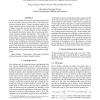Free Online Productivity Tools
i2Speak
i2Symbol
i2OCR
iTex2Img
iWeb2Print
iWeb2Shot
i2Type
iPdf2Split
iPdf2Merge
i2Bopomofo
i2Arabic
i2Style
i2Image
i2PDF
iLatex2Rtf
Sci2ools
ISBI
2007
IEEE
2007
IEEE
Sub-Resolution Maximum-Likelihood Based Localization of Fluorescent Nanoparticles in Three Dimensions
Several recent studies have shown that fluorescent particles can be localized with an accuracy that is well beyond traditional resolution limits. Using a theoretical model of the image formation process that accounts for possible sources of noise, Cram´er-Rao bounds have been used to define the theoretical limits. A crucial influence on these bounds is the mismatch of refractive indices that is usually present between immersion medium and specimen. This results in an axially shift-variant point spread function, meaning that the bounds change as a function of the particle’s position in the zdirection. We investigate the theoretical bounds for this shiftvariant model, and propose a maximum-likelihood estimator for the particle position in 3D (XYZ position). Using this estimator, sub-resolution localization at the nanometer scale is demonstrated on experimental data. The results provide optimal conditions for particle tracking and localization experiments.
Cram´er-Rao Bounds | ISBI 2007 | Medical Imaging | Theoretical Bounds | Traditional Resolution Limits |
| Added | 03 Jun 2010 |
| Updated | 03 Jun 2010 |
| Type | Conference |
| Year | 2007 |
| Where | ISBI |
| Authors | François Aguet, Dimitri Van De Ville, Michael Unser |
Comments (0)

